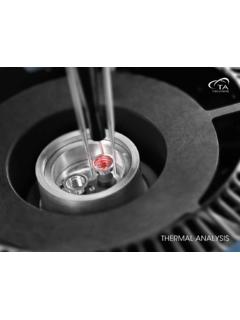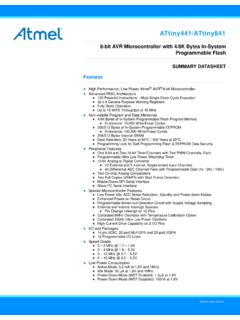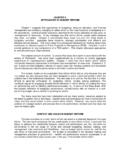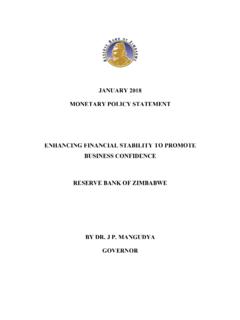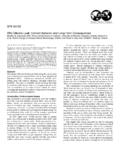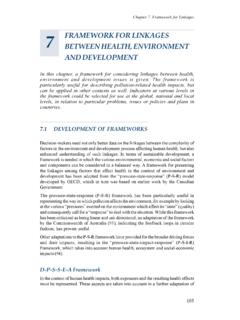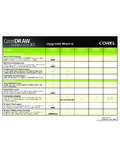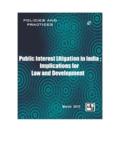Transcription of PV Inverter Design Using Solar Explorer Kit (Rev. A)
1 ApplicationReportSPRABR4A July 2013PV InverterDesignUsingSolarExplorerKitManis hBhardwajand ApplicationsTeamABSTRACTT hisapplicationreportgoesoverthe solarexplorerkit hardwareand explainscontroldesignof PhotoVoltaic(PV)inverterusingthe the of Figures1 TMDSSOLAR(P/C) the PV Link Capacitorand Rippleon the DC PV Grid PV Grid Off Grid BlockDiagramWithC2000 MCU(connectivityperipheralscan differfromone deviceto the otherincludingEthernet,USB,CAN,SPI, and so forth)..2424 SolarExplorerJumpersand ,Piccolo,Concertoare trademarksof othertrademarksare the propertyof July 2013PV InverterDesignUsingSolarExplorerKitSubmi tDocumentationFeedbackCopyright 2013, InverterSoftwareStructure(i) MainLoop(ii) InverterStageISR (iii) DC-ACWithGrid Boostand ControlSchemefor the PV of Tables1PV :PWM,ADC,GPIO, Connectorson solarexplorerkit, TMDSSOLAR(P/C)EXPKIT,(seeFigure1) providesa flexibleand low voltageplatformto evaluatethe C2000 microcontrollerfamilyof devicesfor a varietyof PV and kit is availablethroughthe TI e-store( ).
2 Figure1. TMDSSOLAR(P/C)EXPKIT2PV InverterDesignUsingSolarExplorerKitSPRAB R4A July 2013 SubmitDocumentationFeedbackCopyright 2013, KitWARNINGThisEVMis meantto be operatedin a lab environmentonlyand isnot consideredby TI to be a finishedend-productfit for usedonlyby qualifiedengineersandtechniciansfamiliar withrisksassociatedwithhandlinghighvolta geelectricalandmechanicalcomponents, voltagesand currentsthat can resultinelectricalshock,fire hazardandpersonalinjuryif not properlyhandledor usedwithnecessarycautionandsafeguardsemp loyedto is yourresponsibilityto confirmthatthe voltagesand isolationrequirementsare identifiedand understood,priorto energizingtheboardand or ,the EVMor componentsconnectedto the EVMshouldnot be ContentsThe kit followsthe controlCARD conceptand any devicefromthe C2000familywith the DIMM100controlCARDcan be usedwith the kit. The kit is availablewith two part numbers:TMDSSOLARPEXPKITand TMDSSOLARPEXPKIT shipswith the F28035 MCUcontrolCARD,whichis part of the Piccolo familyin the C2000 MCUproductline and TMDSSOLARCEXPKIT shipswith the F28M35xcontrolCARD,whichis part of the Concerto coredevices,whereone,C28xCore,handlesthe controlof the powerstageand theothercore(ARMcore)handlesthe communicationsuchas USB, kit consistsof.
3 F28M3H52 CcontrolCARD(TMDSSOLARCEXPKIT) F28035controlCARD(TMDSSOLARPEXPKIT) SolarExplorerBaseboard 20 V 2 AmpsPowerSupply BananaPlugCords(installedon the board) 50W24 VacLightBulb USB-Bto A Cable USBmini to A CableThe controlCARD sare pre-flashedto run with the respectivegraphicaluserinterface(GUI)for a of the softwareprojectsare availablefor the kit July 2013PV InverterDesignUsingSolarExplorerKitSubmi tDocumentationFeedbackCopyright 2013,TexasInstrumentsIncorporatedPV Panel EmulatorLight SensorPiccolo-AACDCP owerAdapterDC-DCBuck/BoostDC-DCBoostConv erter + Inverter + Battery ChargerDC-ACInverterMPPTDC-DCSEPICMPPT+ DIMM100PV InverterDemo GUISPIP anel VoltagePower4035302520151050051015202530 GettingFamiliarWiththe OverviewThe solarpanelor PhotoVoltaic(PV)panel,as it is morecommonlycalled,is a DC sourcewith a non-linearV vs I varietyof powertopologiesare usedto conditionpowerfromthe PV sourceso that it can be usedinvarietyof applicationssuchas to feedpowerinto the grid (PV Inverter )and TexasInstrumentsC2000microcontrollerfami ly,with its enhancedperipheralset and optimizedCPUcoreforcontroltasks,is idealfor solarexplorerkit shownin Figure2 has differentpowerstagesthat can enablethe kit to be usedin avarietyof inputto the solarexplorerkit is a 20 V DC powersupplythatpowersthe controllerand the 50 Wsolarpanelcan be connectedto the board(typicalvaluesVmpp17V,Pmax50W).
4 However,for quickdemonstrationof the powerprocessingfromthe solarpanel,a PV emulatorpowerstageis integratedon the boardalongwith otherstagesthat areneededto processpowerfromthe Piccolo-Adeviceintegratedon the boardlessenstheburdenof the controllerusedto controlthe solarpowerconditioningcircuitcontrolof the PV ,the boardusestwo C2000controllers,a dedicatedPiccolo-Adeviceis presenton the baseboardand usedto controlthe PV deviceon the DIMM100controlCARDis usedto controlthe DC-DCBoost,DC-ACand SolarExplorerKit OverviewAs PV is a light dependentsource,a light sensoris integratedon the board,whichcan be usedto changebehaviorof the panelwith varyinglight InverterDesignUsingSolarExplorerKitSPRAB R4A July 2013 SubmitDocumentationFeedbackCopyright 2013, the Kit3 PowerStageson the KitTo enableeasydebugindividualpowerstageshave theirinputand outputavailableas of this macro-basedapproachin hardware,it is possibleto realizedifferentPVsystemsusingthe NomenclatureFigure3 showsthe locationof the differentpowerstageblocksand macrospresenton the board.
5 TMDSSOLAREXPLKit MainBoard[Main] Consistsof controlCARD socket,light sensor,relay,communications,instrumentat ion(DAC s) and routingof signalsin betweenthe macrosand to thecontrolCARD. BoostDC-DCSinglePhasewithMPPT[M1] DC-DCmacroacceptsDC inputthat can be fromthePV panelor a batteryoutput(dependingon systemconfiguration),and boostsit. This blockhas thenecessaryinputsensingto implementMPPT. InverterSinglePhase[M2] DC-ACmacroacceptsa DC voltageand usesa full bridgesinglephaseinverterto generatea sine outputfilter,filtershigh frequencies,therefore,generatingasmooths ine waveat the output. SepicDC-DCwithMPPTB atteryCharging[M3] DC-DCmacroacceptsDC inputfromthe PVpaneland is usedto chargea sepicstageprovidesbothbuckand boostcapabilitiesthatare necessarywhilechargingthe battery. SyncBuckBoostDC-DCPanelEMU[M4] DC-DCmacroacceptsDC inputfromthe DC powerentrymacro(20 V typical)and usesit to generatethe PV modulesensesthe outputvoltageand currentthat makesemulationof the panel s V vs I characteristicspossible.
6 Pic-AUSB-miniEMU[M5] This is a macrowith the TMS320F28027microcontrollerand the JTAG emulatorpresentto controland debugthe M4 stage. DC-PwrEntryVinSw12V 5V 3V3 [M6]- DC powerentry,usedto generatethe 12 V, 5 V and V forthe boardfrom20 V DC powersupplysuppliedwith the kit. This macroalso suppliespowerfor the on-boardpanelemulator,M4. ISO USBto JTAG[M7] JTAG connectionto the :Componentsare referencedwith the macronumberin brackets,followedby example,[M3]-J1wouldreferto the jumperJ1 locatedin the ,[Main]-J1wouldreferto the jumperJ1 locatedon the mainboardoutsideof any July 2013PV InverterDesignUsingSolarExplorerKitSubmi tDocumentationFeedbackCopyright 2013,TexasInstrumentsIncorporatedPowerSt ageson the MacroBlockon SolarExplorerKitThe followingsectiongoesthroughthe individualmacrosand the InverterDesignUsingSolarExplorerKitSPRAB R4A July 2013 SubmitDocumentationFeedbackCopyright 2013,TexasInstrumentsIncorporatedPiccolo Digital ControllerPWMnAD1L1 IpvVpvIpvVpvVboostIboostswIboostswPWMnAC iCoSignal I/F ConditioningDriversQ1 Vboost++ the : 0 -30 V (PanelInput)InputCurrent: 0- Amps(PanelInput)OutputVoltage: 30 V DC NominalOutputCurrent:0-2 AmpsPowerRating.
7 50 Wfsw = 100 singlephasebooststageis usedto boostthe voltagefromthe paneland trackthe inputcurrentIpvis sensedbeforethe inputcapacitanceCialongwith the panelvoltageVpv. Thesetwo valuesare thenusedby the MPPT algorithm,whichcalculatesthe referencepointthe panelinputneedsto bemaintainedat to be at MPPTis realizedusingan outervoltageloop and an innercurrentloop,as shownin currentreferenceof the boost(currentdrawnthroughthe boostloads,the panelandresultingin the paneloutputvoltagedrop).Therefore,the sign for the outervoltagecompensatorreferenceand feedbackare is notedthat the outputof the boostis not preventthe outputvoltagefromrisinghigherthanthe ratingof the components,the voltagefeedbackis mappedtothe internalcomparators,whichcan do a cycle-by-cycletrip of the PWMin caseof July 2013PV InverterDesignUsingSolarExplorerKitSubmi tDocumentationFeedbackCopyright 2013,TexasInstrumentsIncorporatedPiccolo Digital ControllerPWM4AD1L1 IpnlVpnlIpnlVpnlVbattIbattswIbattswPWM4A C1C3 Signal I/F ConditioningDriversQ1 Vbatt+++C2L2 IpvVpvVpvIboostswIboostsw_RefGvVpv_refVb oost_maxGiPWMTo PlantVboostMPPTV=func(V , I )pv_refpv pvRuns in a slowbackground task,not timing criticalRuns as Plant switchingfrequency or half for cycleby cycle the internal comparator trip toimplement the overvoltageprotection.
8 If the Vis greater thanmax, the output is zero and this zeroesthe duty and trips the ++ *+ PowerStageson the ,SepicFigure6. : 0 -30 V (PanelInput)InputCurrent: 0- Amps(PanelInput)OutputVoltage: 10V-16 VDC :50 WMaxfsw = 200 Khz8PV InverterDesignUsingSolarExplorerKitSPRAB R4A July 2013 SubmitDocumentationFeedbackCopyright 2013, the stageis responsiblefor charginga typical12 V batteryfromthe solarpaneland,therefore,has panelcurrentIpvand panelvoltageVpvsensingto sepicstagewas chosento realizethis function,as bothbuckand boostoperationare possibleusingthe typicallead acid batterychargingcan be dividedinto four stages,stagedeterminationand transitionis doneas: TrickleChargingState:Whenthe batteryvoltageis belowa dischargethresholdVchgenb, the batteryhasbeendeeplydischargedor has this case,the chargingbeginswith a very low tricklecurrentItc. If the batterycellsare shorted,thenthe batteryvoltagewouldremainbelowthe Vchgenb,preventingthe chargingstatefromgoingto the bulk ,the batteryvoltagewouldslowlybuildup and wouldcomewithina nominalrange(aboveVchgenb).
9 At this stage,the statewouldmoveto bulk tricklechargingmode,MPPTmay not be needed. BulkChargingState:In this stage,the chargeracts like a currentsourcefor the batteryprovidingaconstantcurrentIbulk. As the PV may not be able to supplythe idealIbulkto chargethe battery,however,it tries its best by operatingat the , the chargerenterstheoverchargermode. OverChargingState:The role of this stateis to restorethe full capacityin minimumamountof time atthe sametime the batteryvoltageand currentloop are enabledwhileMPPTis equalsVoc. Initially,overchargecurrentequalsbulk chargecurrent,but asoverchargevoltageis approached,the determinedby the voltageloop. FloatChargeState:Duringthis state,the batteryvoltageis maintainedat Vfloatto maintainbatterycapacityagainstself chargerwoulddeliveras muchcurrentis neededfor sustainingthe float batterywouldremainin the float stateuntil the batteryvoltagedropsbelow90%of the float voltagedue to discharging,at whichpointoperationis revertedto bulk 12V batteryare:OverchargeVoltage,Voc=15 VFloatingVoltage,Vfloat= ,Vchgenb= ,Vldv= ,Vldv= illustratesthe controlproposedfor this controlwhendoingMPPT issimilarto the booststage.
10 However,whenthe batteryis not in the bulk chargingstage,the MPPcannotbemaintainedas the batterycannotabsorbthe max powerfromthe ,the controlof the stagechangesfromthe inputvoltageof the stageor outputof the panelregulationto the outputvoltageof the instancewhenthe controlis switchedisdependenton the batterytype and July 2013PV InverterDesignUsingSolarExplorerKitSubmi tDocumentationFeedbackCopyright 2013,TexasInstrumentsIncorporatedPiccolo Digital ControllerPWM1 AVdcVacIleg1 Ileg2 Signal I/F ConditioningDriversPWM1 BPWM2 APWM2 BGrid+VdcQ1Q3Q2Q4C1 Ileg1 Ileg2L1L2 VlineVneutralCacPWM1 APWM1 BPWM2 APWM2 BGvPWMMPPTIref=func(Vpnl, Ipnl)Vpnl_RefIpnlVpnlVpnlTo PlantVbatt_refVbatGvBulk Charging StateTrickle, Over and Float Charging StateBattery Charge StateDeterminationRuns in a slowbackground task,not timing critical-++-PowerStageson the SinglePhaseFull BridgeInverterPowerStage10PV InverterDesignUsingSolarExplorerKitSPRAB R4A July 2013 SubmitDocumentationFeedbackCopyright 2013, the : 30 V DC NominalInputCurrent: 0- 2 AmpsOutputVoltage: 20-24 VrmsMaxOutputCurrent:0-2 AmpsPowerRating:50 Wfsw = 10 appreciatethe controlof a full bridgeinverter,first the mechanismof how the high frequencyfull bridgeinverterfeedscurrentinto the grid and line needsto be this, an understandingof thePWMmodulationschemeis followingderivationsusesthe unipolarmodulationschemetoanalyzethe currentfed fromthe a unipolarmodulationscheme,alternatelegs are switcheddependingon whichhalf of the sine of theAC signalis beinggenerated.










